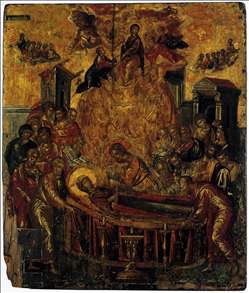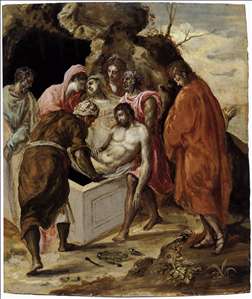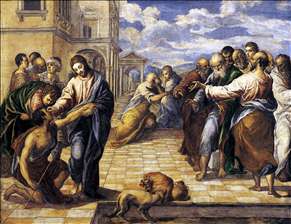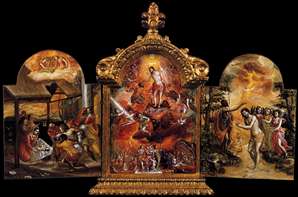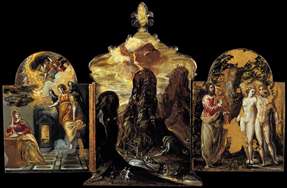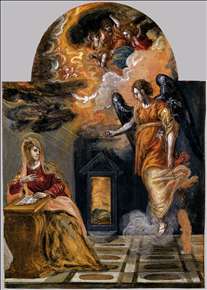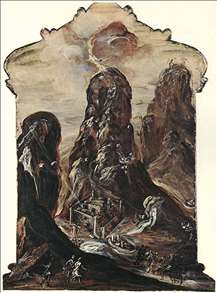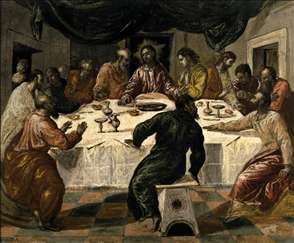Cretan-born painter, sculptor, and architect who settled in Spain and is regarded as the first great genius of the Spanish School. He was known as El Greco (the Greek), but his real name was Domenikos Theotokopoulos; and it was thus that he signed his paintings throughout his life, always in Greek characters, and sometimes followed by Kres (Cretan).
Little is known of his youth, and only a few works survive by him in the Byzantine tradition of icon painting, notably the Dormition of the Virgin discovered in 1983 (Church of the Koimesis tis Theotokou, Syros). In 1566 he is referred to in a Cretan document as a master painter; soon afterwards he went to Venice (Crete was then a Venetian possession), then in 1570 moved to Rome. The miniaturist Giulio Clovio, whom he met there, described him as a pupil of
Titian, but of all the Venetian painters
Tintoretto influenced him most (e.g. Christ Healing the Blind, c. 1570), and
Michelangelo s impact on his development was also important (e.g. Pietà, c. 1572, Philadelphia Museum of Art).
Among the surviving works of his Italian period are two paintings of the Purification of the Temple (Minneapolis Institute of Arts), a much-repeated theme, and the portrait of Giulio Clovio (Museo di Capodimonte. Naples). By 1577 he was at Toledo, where he remained until his death, and it was there that he matured his characteristic style in which figures elongated into flame-like forms and usually painted in cold, eerie, bluish colours express intense religious feeling. The commission that took him to Toledo the high altarpiece of the church of S. Domingo el Antiguo - was gained through Diego de Castilla, Dean of Canons at Toledo Cathedral, whom El Greco had met in Rome. The central part of the altarpiece, a 4-m. high canvas of The Assumption of the Virgin (Art Institute of Chicago, 1577), was easily his biggest work to date, but he carried off the dynamic composition triumphantly. A succession of great altarpieces followed throughout his career, the two most famous being El Espolio (Christ Stripped of His Garments) (Toledo Cathedral, 1577-79) and The Burial of Count Orgaz (S. Tome, Toledo. 1586-88). These two mighty works convey the awesomeness of great spiritual events with a sense of mystic rapture, and in his late work El Greco went even further in freeing his figures from earth-bound restrictions: The Adoration of the Shepherds (Prado, Madrid, 1612-14), painted for his own tomb, is a prime example.
El Greco excelled also as a portraitist, mainly of ecclesiastics (Felix Paravicino, Boston Museum, 1609) or gentlemen, although one of his most beautiful works is a portrait of a lady (Art Gallery & Museums Kelvingrove, Glasgow, c. 1577-80), traditionally identified as a likeness of Jeronima de las Cuevas, his common-law wife. He also painted two views of Toledo (Metropolitan Museum, New York, and Museo del Greco, Toledo), both late works, and a mythological painting, Laocon (National Gallery of Art, Washington, c. 1610), that is unique in his oeuvre. The unusual choice of subject is perhaps explained by the local tradition that Toledo had been founded by descendants of the Trojans.
El Greco also designed complete altar compositions, working as architect and sculptor as well as painter, for instance at the Hospital de la Caridad, Illescas (1603).
Pacheco, who visited El Greco in 1611, refers to him as a writer on painting, sculpture, and architecture. He had a proud temperament, conceiving of himself as an artist-philosopher rather than a craftsman, and had a lavish lifestyle, although he had little success in securing the royal patronage he desired and seems to have had some financial difficulties near the end of his life.
His workshop turned out a great many replicas of his paintings, but his work was so personal that his influence was slight, his only followers of note being his son
Jorge Manuel Theotokopoulos and Luis
Tristan. Interest in his art revived at the end of the 19th century and with the development of Expressionism in the 20th century he came into his own. The strangeness of his art has inspired various theories, for example that he was mad or suffered from astigmatism, but his rapturous paintings make complete sense as an expression of the religious fervour of his adopted country.
